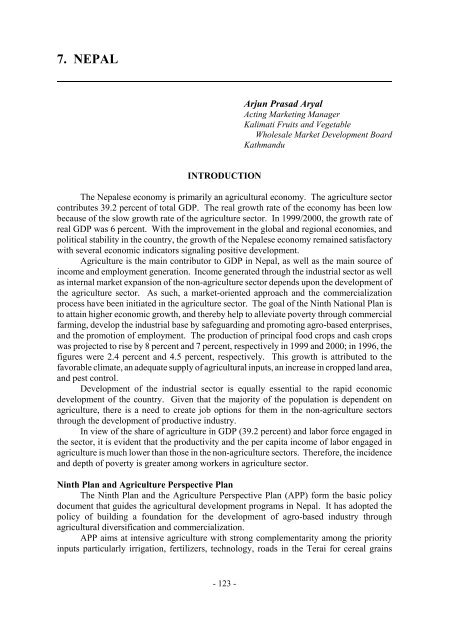Development of Agribusiness Enterprises - Asian Productivity ...
Development of Agribusiness Enterprises - Asian Productivity ...
Development of Agribusiness Enterprises - Asian Productivity ...
You also want an ePaper? Increase the reach of your titles
YUMPU automatically turns print PDFs into web optimized ePapers that Google loves.
7. NEPAL<br />
INTRODUCTION<br />
- 123 -<br />
Arjun Prasad Aryal<br />
Acting Marketing Manager<br />
Kalimati Fruits and Vegetable<br />
Wholesale Market <strong>Development</strong> Board<br />
Kathmandu<br />
The Nepalese economy is primarily an agricultural economy. The agriculture sector<br />
contributes 39.2 percent <strong>of</strong> total GDP. The real growth rate <strong>of</strong> the economy has been low<br />
because <strong>of</strong> the slow growth rate <strong>of</strong> the agriculture sector. In 1999/2000, the growth rate <strong>of</strong><br />
real GDP was 6 percent. With the improvement in the global and regional economies, and<br />
political stability in the country, the growth <strong>of</strong> the Nepalese economy remained satisfactory<br />
with several economic indicators signaling positive development.<br />
Agriculture is the main contributor to GDP in Nepal, as well as the main source <strong>of</strong><br />
income and employment generation. Income generated through the industrial sector as well<br />
as internal market expansion <strong>of</strong> the non-agriculture sector depends upon the development <strong>of</strong><br />
the agriculture sector. As such, a market-oriented approach and the commercialization<br />
process have been initiated in the agriculture sector. The goal <strong>of</strong> the Ninth National Plan is<br />
to attain higher economic growth, and thereby help to alleviate poverty through commercial<br />
farming, develop the industrial base by safeguarding and promoting agro-based enterprises,<br />
and the promotion <strong>of</strong> employment. The production <strong>of</strong> principal food crops and cash crops<br />
was projected to rise by 8 percent and 7 percent, respectively in 1999 and 2000; in 1996, the<br />
figures were 2.4 percent and 4.5 percent, respectively. This growth is attributed to the<br />
favorable climate, an adequate supply <strong>of</strong> agricultural inputs, an increase in cropped land area,<br />
and pest control.<br />
<strong>Development</strong> <strong>of</strong> the industrial sector is equally essential to the rapid economic<br />
development <strong>of</strong> the country. Given that the majority <strong>of</strong> the population is dependent on<br />
agriculture, there is a need to create job options for them in the non-agriculture sectors<br />
through the development <strong>of</strong> productive industry.<br />
In view <strong>of</strong> the share <strong>of</strong> agriculture in GDP (39.2 percent) and labor force engaged in<br />
the sector, it is evident that the productivity and the per capita income <strong>of</strong> labor engaged in<br />
agriculture is much lower than those in the non-agriculture sectors. Therefore, the incidence<br />
and depth <strong>of</strong> poverty is greater among workers in agriculture sector.<br />
Ninth Plan and Agriculture Perspective Plan<br />
The Ninth Plan and the Agriculture Perspective Plan (APP) form the basic policy<br />
document that guides the agricultural development programs in Nepal. It has adopted the<br />
policy <strong>of</strong> building a foundation for the development <strong>of</strong> agro-based industry through<br />
agricultural diversification and commercialization.<br />
APP aims at intensive agriculture with strong complementarity among the priority<br />
inputs particularly irrigation, fertilizers, technology, roads in the Terai for cereal grains
















